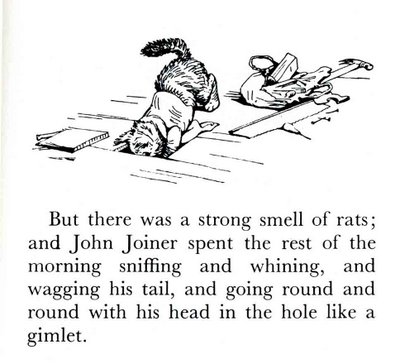The Roly-Poly Pudding

The Roly-Poly Pudding Or, The Tale of Samuel Whiskers (1908) is one of Beatrix Potter's most beloved works. Artfully-limned characters, exacting illustrations, and clever dialog combine to create a high-drama adventure.
The reader is prepared to enter into the nuanced cares and concerns of the animal world through Potter's dedication of the work to the rat "SAMMY."
Below a fine line portrait, Sammy is lauded as "the intelligent pink-eyed representative of a persecuted (but irrepressible) race[,] an affectionate little friend, and most accomplished thief".
We begin the story...
ONCE upon a time there was an old cat, called Mrs. Tabitha Twitchit, who was an anxious parent. She used to lose her kittens continually, and whenever they were lost they were always in mischief!There are three kittens, and Tom is the most vexing:
"I've lost my dear son Thomas; I'm afraid the rats have got him."Mrs. Tabitha and her visitor, Cousin Ribby, look everywhere, and find Moppet and Mittens, but not Tom.
Ribby and Tabitha searched and searched. They both heard a curious roly-poly noise under the attic floor. But there was nothing to be seen.In fact, Tom has climbed up inside an old chimney and been captured by rats. There's a struggle between Tom and an old rat couple, ending with them tying him up tightly with string.
The rats decide to make the unfortunate Tom into a (baked) pudding. The rat couple steal dough, flour, butter, and a rolling pin from the kitchen. Moppet and Mittens testify:
"Oh! Mother, Mother, there has been an old man rat in the dairy -- a dreadful 'normous big rat, Mother; and he's stolen a pat of butter and the rolling-pin."Meanwhile the rats continue at their pudding-preparation:
Ribby and Tabitha looked at one another.
"A rolling-pin and butter! Oh, my poor son Thomas!" exclaimed Tabitha, wringing her paws.
"A rolling-pin?" said Ribby. "Did we not hear a roly-poly noise in the attic when we were looking into that chest?"

Mrs. Twitchit summons John Joiner, a carpenter (and a scotty-type dog) to saw a hole into the floor in an effort to find Tom. John Joiner lifts a floor plank and Tom is found and freed.
Tom Kitten bit and spat, and mewed and wriggled; and the rolling-pin went roly-poly, roly; roly, poly, roly. The rats each held an end."His tail is sticking out! You did not fetch enough dough, Anna Maria."
"I fetched as much as I could carry," replied Anna Maria.
"I do not think" -- said Samuel Whiskers, pausing to take a look at Tom Kitten -- "I do not think it will be a good pudding. It smells sooty."
But John Joiner continues to be troubled by the presence of rats:

Eventually he gives up the effort, goes downstairs, and is invited to stay to dinner.
The dumpling had been peeled off Tom Kitten, and made separately into a bag pudding, with currants in it to hide the smuts.*And with a little more on Miss Potter's sighting of the rats as they escape, and Moppet's and Mitten's future careers as rat-catchers (and Tom's life-long fear of rats), our story comes to a close.They had been obliged to put Tom Kitten into a hot bath to get the butter off.
John Joiner smelt the pudding; but he regretted that he had not time to stay to dinner, because he had just finished making a wheel-barrow for Miss Potter, and she had ordered two hen-coops.
Beatrix Potter
Beatrix Potter was an acute observer of the natural world, a gifted and exacting scientific illustrator, and hoped to make a career for herself in the biological sciences. She was an accomplished mycologist, and may have been one of the first to present evidence that lichen are in fact a symbiotic combination of two separate species, an alga and a fungus.
The mores of the age -- the Linnean Society, for example did not admit women -- and the insensitivity of individuals -- one botanist told her that her drawing lacked scientific utility -- effectively shut her off from professional scientific pursuits. A review in the Taxon of May 1999 (available here through JSTOR) describes the "trouble about the paper " - her paper "On the Germination of Spores of Agaricineae" read by the mycologist George Massee before the Linnean Society in 1897.
She continued to draw, and her interest in illustration eventually led her to create illustrated children's tales.
Fogler Resources
A search in URSUS for Potter as an author leads to a number of her tales, especially in the Learning Materials Center. A search by subject leads to biographies, criticism, and collections of her correspondence, including Beatrix Potter's Americans: Selected Letters by UMaine's Jane Crowell Morse.
The Fogler Children's Literature Portal is a good starting point for critiques of Potter's children's works, biographical essays, and references on children's literature of the Victorian and Edwardian eras, as well, of course, for more current children's authors and works.
The MLA Bibliography is a good source for critical articles on Potter and her work, as is Literature Resource Center.
On the Web
The full text of The Roly-Poly Pudding, with scanned illustrations, is available here, at the University of Virginia's Electronic Text Center. The ETC also makes available a number of other Potter tales.
A web search on "Beatrix Potter" results in an enormous number of links to commercial, amateur, and scholarly sites devoted to Potter, her world, and her work. A few of interest are listed here, but no particular endorsement is implied!
- Beatrix Potter (Wikipedia) (includes a list of her works)
- The Beatrix Potter Society
- World of Peter Rabbit (F. Warne site)
* A "smut," we learn from the Oxford English Dictionary, is, among other things, soot or sooty matter, or a particle of sooty matter. Just the thing to flavor a pudding!

No comments:
Post a Comment